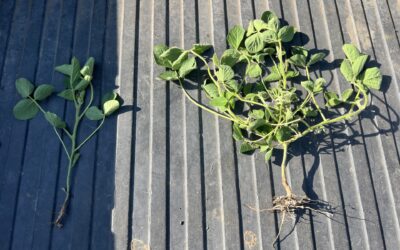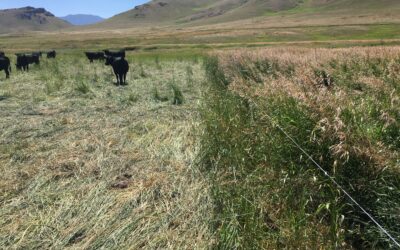Aggregate Stability
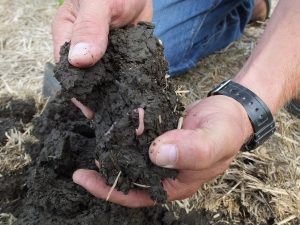 Soil aggregates are groups of soil particles that bind to each other more strongly than to adjacent particles. Aggregate stability refers to the ability of soil aggregates to resist disintegration when disruptive forces associated with tillage and water or wind erosion are applied. Wet aggregate stability suggests how well a soil can resist raindrop impact and water erosion, while size distribution of dry aggregates can be used to predict resistance to abrasion and wind erosion.
Soil aggregates are groups of soil particles that bind to each other more strongly than to adjacent particles. Aggregate stability refers to the ability of soil aggregates to resist disintegration when disruptive forces associated with tillage and water or wind erosion are applied. Wet aggregate stability suggests how well a soil can resist raindrop impact and water erosion, while size distribution of dry aggregates can be used to predict resistance to abrasion and wind erosion.
Relationship to Soil Function
Changes in aggregate stability may serve as early indicators of recovery or degradation of soils. Aggregate stability is an indicator of organic matter content, biological activity, and nutrient cycling in soil. Generally, the particles in small aggregates (<0.25 mm) are bound by older and more stable forms of organic matter. Microbial decomposition of fresh organic matter releases products (that are less stable) that bind small aggregates into large aggregates (>2-5 mm). These large aggregates are more sensitive to management effects on organic matter, serving as a better indicator of changes in soil quality. Greater amounts of stable aggregates suggest better soil quality.When the proportion of large to small aggregates increases,soil quality generally increases.
Stable aggregates can also provide a large range in pore space, including small pores within and large pores between aggregates. Pore space is essential for air and water entry into soil, and for air, water, nutrient, and biota movement within soil. Large pores associated with large, stable aggregates favor high infiltration rates and appropriate aeration for plant growth. Pore space also provides zones of weakness for root growth and penetration.
Problems with Poor Function
Aggregate stability is critical for infiltration, root growth, and resistance to water and wind erosion. Unstable aggregates disintegrate during rainstorms. Dispersed soil particles fill surface pores and a hard physical crust can develop when the soil dries. Infiltration is reduced, which can result in increased runoff and water erosion, and reduced water available in the soil for plant growth. A physical crust can also restrict seedling emergence.
Wind normally detaches only loosely held particles on the soil surface, but as blowing soil particles are accelerated by the wind they hit bare soil with sufficient energy to break additional particles loose from weakly aggregated soil. This action increases the number of particles that can be picked up by the wind and abrade a physically-unprotected soil surface.
Practices that lead to poor aggregate stability include:
- Tillage methods and soil disturbance activities that breakdown plant organic matter, prevent accumulation of soil organic matter, and disrupt existing aggregates,
- Cropping, grazing, or other production systems that leave soil bare and expose it to the physical impact of raindrops or wind-blown soil particles,
- Removing sources of organic matter and surface roughness by burning, harvesting or otherwise removing crop residues,
- Using pesticides harmful to beneficial soil microorganisms.
Improving Aggregate Stability
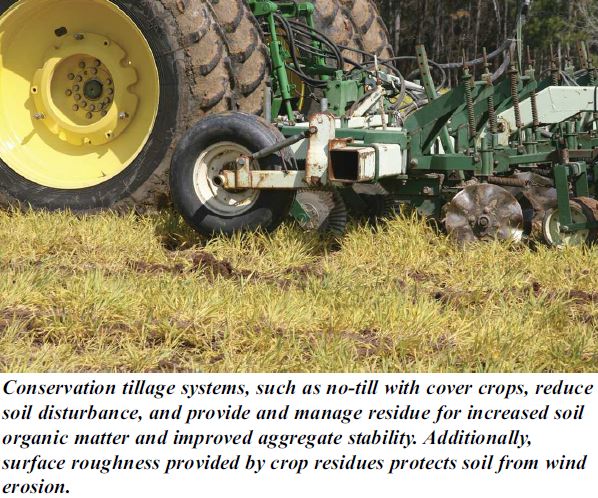 Practices that keep soil covered physically protect it from erosive forces that disrupt aggregation, while also building organic matter. Any practice that increases soil organic matter, and consequently biological activity, improves aggregate stability. However, it can take several growing seasons or years for significant organic matter gains. In contrast, management activities that disturb soil and leave it bare can result in a rapid decline in soil organic matter, biological activity and aggregate stability.
Practices that keep soil covered physically protect it from erosive forces that disrupt aggregation, while also building organic matter. Any practice that increases soil organic matter, and consequently biological activity, improves aggregate stability. However, it can take several growing seasons or years for significant organic matter gains. In contrast, management activities that disturb soil and leave it bare can result in a rapid decline in soil organic matter, biological activity and aggregate stability.
Aggregates form readily in soil receiving organic amendments, such as manure. They also form readily where cover and green manure crops and pasture and forage crops are grown, and where residue management and/or reduced tillage methods are used.
Improving aggregate stability on cropland typically involves cover and green manure crops, residue management, sod-based rotations, and decreased tillage and soil disturbance. Aggregate stability declines rapidly in soil planted to a clean-tilled crop.
Pasture and forage plants have dense, fibrous root systems that contribute organic matter and encourage microbial activity. However, grazing and fertility must be managed to maintain stands and prevent development of bare areas or sparse vegetation.
Conservation practices resulting in aggregate stability favorable to soil function include:
- Conservation Crop Rotation
- Cover Crop
- Pest Management
- Prescribed Grazing
- Residue and Tillage Management
- Salinity and Sodic Soil Management
- Surface Roughening
This Page Was Created Utilizing Text And Images From These Sources:
Aggregate Stability, Soil Quality Indicators Fact Sheet- USDA Natural Resources Conservation Service
South Dakota Natural Resources Conservation Service Flickr Account
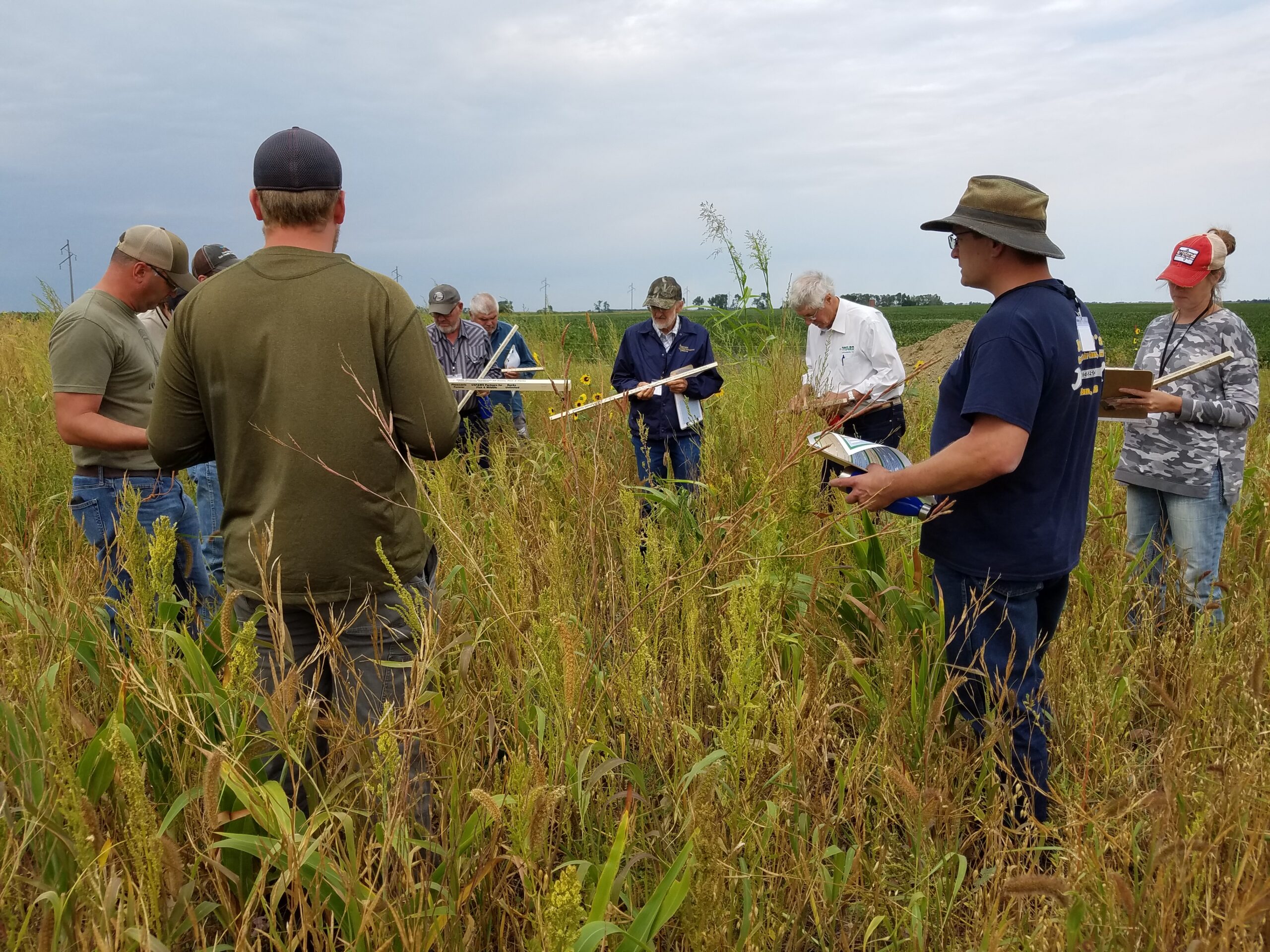
West River Soil Health School Registration Open!
In 2024, the South Dakota Soil Health Coalition will host an additional Soil Health School in west of the Missouri River! The 2024 West River Soil Health School with be held June 26-27 near Caputa, SD! This school will focus on issues specific to the land, climate, and ag production systems of wester South Dakota. Class size is limited, so early registration is strongly encouraged!
News & Events
Farmer reaps higher yields by interseeding soybeans
By Stan Wise Alex Frasier has spent a lot of time studying what it takes to grow a successful crop. After studying ag production and precision technology at Lake Area Technical College, he has worked in ag retail and currently works as an agronomist in Aberdeen, SD....
Farm and ranch innovators to share new ideas at Soil Health Conference
By Stan Wise PIERRE, SD — Before Cooper Hibbard came home to manage his family’s ranch, he studied ag business, rangeland resources and Spanish at California Polytechnic State University and then worked on ranches all over the world. That education and experience...
Wintertime is decision time
By Stan Wise PIERRE, SD – It’s often said that the best time to start improving your land was 20 years ago, but the second-best time is right now. That statement might be harder for ranchers to swallow with winter on their doorstep, nothing growing in their pastures,...
